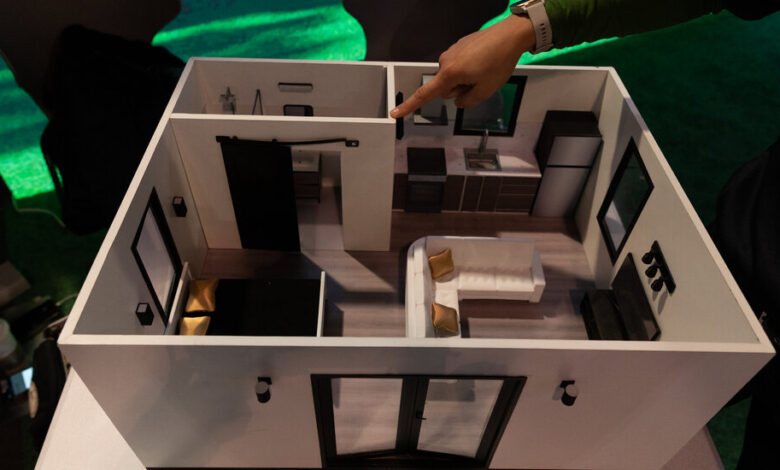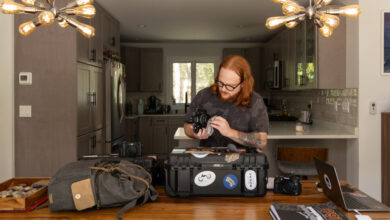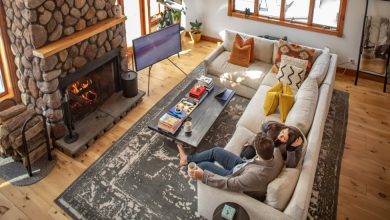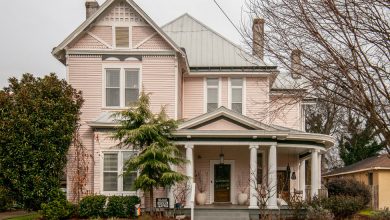Are Tiny Homes a Solution to the Housing Crisis? These Builders Think So.

[ad_1]
A tug of war is being waged over the size of the American home.
Pulling in one direction are the forces of expansion: the well-financed dream for many of a sprawling single-family house; the NIMBY activism that prevents the incursions of multifamily buildings into low-density neighborhoods; and — not least, in the age of Covid — the desire to contain one’s life and work under a single roof without losing one’s mind.
Lining up on the other side are the powers of compression: shrinking family sizes; rising energy costs; and policies that seek to relieve today’s affordable housing crisis by creating more apartments and micro homes.
What is the net effect? That depends on when you freeze the frame. In November, the National Association of Home Builders reported that the median size of new family homes had dipped to 2,276 square feet and was expected to drop more in the coming months, as high interest rates stifled construction budgets. It was a reminder that living small is a topic that looms large.
So for the first installment of a new column called “Living Small” — exploring the choices some people are making to live as simply, sustainably or compactly as possible, for ethical or aesthetic reasons, or both — we visited the association’s annual trade fair, the International Builders’ Show, to see how builders, manufacturers and architects are responding to this struggle.
There is nothing small about IBS, as the show’s name is unfortunately abbreviated. This latest edition, which ended on Feb. 2, was part of a multi-trade-fair extravaganza known as Design and Construction Week, with 1,800 exhibitors spread over a million square feet in the Las Vegas Convention Center.
Beyond the fairgrounds, undeveloped swaths of Las Vegas rolled out to distant, sugary mountains. Inside, vendors showed off their slab siding, permeable pavers, patio doors, crown molding, woolly insulation, architectural design software — and every other imaginable thing used to build a home — while remaining agnostic about size: Shingles are shingles, no matter how big your roof is.
But running through the three-day event was a conversation about constraint, as soaring interest rates and construction material costs, combined with a shortage of available land and skilled labor, have led to a precipitous decline in home building.
Robert Dietz, the chief economist of the National Association of Home Builders, estimated that single-family home starts, which fell 12 percent in 2022 (to 744,000 from 999,000), would drop an additional 26 percent in 2023 before reversing direction. In terms of multifamily housing, Mr. Dietz predicted a 28 percent decline (to 391,000 units in 2023 from 545,000 in 2022).
Based on his group’s data, he reported a 1.5 million deficit in the number of new homes needed to make housing relatively affordable in the United States. “Just 42 percent of new and existing home sales are currently affordable to a typical household, which is a post-Great Recession low,” stated a news release summarizing his analysis.
The show revealed that to make the most of hobbled opportunities, developers, architects and builders are trimming the size of primary residences. Or dropping accessory dwelling units into backyards (20 percent of remodelers have undertaken an ADU project, Mr. Dietz reported). Or investigating new technologies for building affordable housing, including three-dimensional printing or innovations in factory-built structures.
In a presentation called “Small Homes, Big Impact!,” Brad Shapiro, an architect from Memphis, offered suggestions for making it less obvious that 10 to 15 percent had been shaved off a house that in more prosperous times would have been 2,400 square feet. His advice included familiar strategies like adding windows to let in sunshine and using pale interior paint. He also recommended doing away with hallways leading to second-floor bedrooms.
In another presentation, Donald Ruthroff, an architect from Northern California, addressed home trends and buyer preferences. Responding to the pandemic-era clamor for home offices — a National Association of Home Builders survey revealed that 88 percent of home builders had seen an increased demand for them — he said, “The days of offices with bookshelves behind the desk, and a couple of chairs, are over.”
All you need now is a desk and a videoconferencing setup.
Mr. Ruthroff further noted that Americans are asking for kitchens that are “like Swiss Army knives” — not bigger, but better equipped.
“Covid drove people to want larger homes, and low interest rates allowed them to buy them,” said Rose Quint, the association’s assistant vice president for survey research. In fact, she added, the only single-family residential construction category that has shown consistent growth since 2000 is that of properties with four or more bedrooms. These constituted 48 percent of new houses started in 2022, compared with 43 percent in 2019, 34 percent in the recessionary year of 2009 and 36 percent in 2000. (She attributed the increase mainly to adult children living with their parents.)
Yet when buyers were asked about compromises they would make to afford a home, Ms. Quint reported, the leading answer — cited by 45 percent of respondents — was living in a smaller house, followed by having more basic interiors (35 percent) and fewer outdoor amenities (34 percent).
A number of IBS presentations indirectly broached this theme of smaller living, with titles like “Delivering Detached Housing That Is Dense, Desirable and Affordable” and “Champagne Taste on a Beer Budget in a Tightening Market.”
Exhibitors chimed in, too. Scott Philippe, the chief operating officer of a Canadian company called Beyond Sustainable, said he was helping to build a community of small, prefabricated houses in New Brunswick, Canada, that would be rented and eventually sold. (The structural system, called OSBlock, which consists of interlocking wood modules with attached insulation, was displayed a few yards away.)
“Young people don’t want big mortgages or leases, especially after Covid,” Mr. Philippe said. “They want to travel.” (As a sweetener, he is developing housing in Acapulco, Mexico, where renters in the community will get to stay free one week a year.)
Viken Ohanesian, the founder and chief executive of BOSS Homes, near Los Angeles, presented the model of a tiny house: a 320-square-foot structure with paneled walls and a steel roof that three builders can assemble like Lego blocks in three days. (The company’s name is an acronym for “built-on-site system.”) Even upgraded with aluminum windows and doors and a mini-split heating-and-cooling system, the house sells for only a little more than $56,000, and that includes a paint job.
Mr. Ohanesian started his company to build average-size homes, but spun off a tiny-house division several years ago, when California passed legislation allowing ADUs. The customers he envisioned were people like his daughter, Lara Ohanesian, who, despite being BOSS’s project manager, would not be able to afford a house in Southern California without the assistance of rental income from a backyard unit, he said.
And who doesn’t love a little house? Visitors swarmed an outdoor area of the show where several factory-built examples had been erected. The most eye-catching was Casita, a 375-square-foot house that could be hauled to its site by a Tesla and unfolded like a flat-packed box. Manufactured by Boxabl, a Nevada-based company, Casita comes with plumbing, electricity and appliances, and costs $60,000. According to David Thompson, the company’s social media manager, 160,000 names are on the waiting list, and Elon Musk uses one as a guesthouse at his ranch in Boca Chica, Texas.
Next to Casita was a Boxabl sibling created from two vertically stacked modules joined by a spiral staircase. The cost-cutting finishes of the houses lent a disposable feeling, like Ikea furniture on an enormous scale, but it was hard to argue with the price and speed of assembly. (Unfolding a module takes about an hour, Mr. Thompson said.)
On the other side of this exhibit was a 1,409-square-foot modular cottage from Impresa Building Systems, in Greenwood, S.C., with an overhanging roof supported by columns and front and back porches. (Impresa houses average about $200 to $250 a square foot for the building and all site work, according to the company’s website.) This exercise in traditional charm had two bedrooms, one and a half bathrooms and a sleeping loft.
A couple of skeptics were overheard remarking that more living area could have been extracted from under the vaulted ceiling. They also muttered about the dangers the circular staircase posed to passing heads. It was a tough crowd.
The takeaway from the show was that 2023 will continue to be challenging for home builders and buyers. But with interest rates and construction costs dropping, if only incrementally, the outlook for 2024 is more optimistic. Mr. Dietz forecast a rebound in housing starts in the second half of 2023, culminating in a year-over-year increase of 24 percent next year.
In terms of square footage, Ms. Quint predicted, somewhat counterintuitively, that the average size of houses built this year will grow under economic stress and contract next year when conditions improve: “The move toward larger homes and more amenities in 2023 will reflect the preferences of those who can afford higher interest rates,” she stated in a news release, “and in 2024, size will fall back as affordability improves with lower mortgage rates and more buyers re-enter the market.”
But there was evidence at IBS that shrinking house sizes may be only a blip on a continuum of growth. It came from a concurrent exhibition at the Las Vegas Convention Center: the Kitchen and Bath Industry Show. There, you could find small appliances like 24-inch-wide-washing machines and four-burner stoves, but they were usually in the booths of European companies targeting dense urban markets like New York City.
Many Europeans also presented large appliances that the companies had no intention of selling back home. Ege Uysal, the sales manager of Vestel, a Turkish manufacturer, described the features considered nonnegotiable for a refrigerator for the United States: 18 cubic feet of volume, a water dispenser on the door and — most novel to him — an extra-wide condiment shelf to hold a gallon milk carton.
“Everything is bigger in America,” he said.
For weekly email updates on residential real estate news, sign up here.
[ad_2]
Source link






